Print on demand services offer creators one of the simplest ways to start selling custom products to consumers around the world today.
But there’s more than one way to launch a print on demand business. Spreadshop and Spring are two of the most popular straightforward options, ideal for merchants who want to start selling quickly to an established audience.
However, while both of these solutions are similar on the surface, there are some major differences between them when you dive into the details. I put both of these platforms to the test, to discover which offers the most scalability and growth opportunity to business leaders.
We conduct hands-on tests of platforms and services for our comparison reviews. Learn more about our review and research policy here.
The Quick Verdict, Pros and Cons
Both Spreadshop and Spring are excellent, straightforward solutions for beginners in the print on demand market. They both allow you to create and launch a store for free, without relying on ecommerce platforms.
However, Spring offers lower prices for products, while Spreadshop delivers better quality, and more platform integration options.
Spring Pros and Cons
Pros 👍
- Excellent integrations with social media
- Digital and physical product options
- Integrated analytics and reporting tools
- Convenient, straightforward design
- Rapid live chat customer support
- Integrated marketing options
Cons 👎
- Potential for lower quality products
- No options for integrating with ecommerce platforms
- Some limitations on customization
Spreadshop Pros and Cons
Pros 👍
- Lots of high-quality product options
- Integrated statistics and analytical tools
- Integrations for ecommerce platforms and marketplaces
- Access to lots of additional services
- Phone based support
- Creator Spotlight for promotion
Cons 👎
- No digital product options
- Slower customer support
- Higher base product costs
Spring vs Spreadshop: The Core Features
Both Spring and Spreadshop offer creators a simple solution they can use to launch a free store and start selling custom products online.
Although these online store solutions certainly don’t give you all the functionality you’ll get from a full ecommerce platform, they’re ideal for beginners.
However, there are some differences in the flexibility you’ll get from Spreadshop and Spring.
For instance, Spring is more suited to creators who want to sell through social media, while Spreadshop gives you more freedom to sell across various platforms and marketplaces.
Product Options, Customization, and Quality
First, let’s look at your product options on both platforms. Spreadshop and Spring both give you instant access to a wide range of products you can customize with unique prints and components.
Spreadshop offers over 250 products to customize, including all of the common high-value items like t-shirts, sweaters, and accessories.

Spring offers fewer products (180), mainly focusing on apparel and accessories, like t-shirts and hats. However, it does also allow users to create and sell digital downloads – which is something you don’t get from Spreadshop.
Both options make it easy to customize your products with DTG and similar printing methods, and both allow you to set your own profit margins.
However, I have noticed some differences in product quality. Spreadshop has a relatively strong reputation for producing high-quality items, although some vendors say the base costs of its products are extremely high (around $17 for a printed t-shirt).
Spring’s base costs are lower (around $14 for a t-shirt), but it’s received a lot of complaints about inconsistent print quality.
Fulfillment and Sales Channels
The good news for global sellers, is that both Spreadshop and Spring can deliver your products worldwide, through connections with various logistics partners. Obviously, the delivery times and pricing can vary depending on where your customers are located.
What really separates Spring and Spreadshop, in my opinion, is the sales channel options you’ll have. As mentioned above, both allow you to create free stores that you can promote on social media and other channels.
The stores you’ll get are pretty basic, with simple templates that offer limited customization, and basic reporting and analytics capabilities.
However, they’re a good option for new sellers who want to keep startup costs low. Spreadshop offers direct integrations with a range of social channels too, such as TikTok and Instagram.
Spreadshop, on the other hand, has social media integrations, as well as the unique “SpreadConnect” service.
This allows you to plug your store into existing platforms like Shopify and Amazon, giving you more room to sell custom products across various channels. There’s even a custom API for creating your own automated workflows.
Ease of Use and Customer Support
Getting started with both Spreadshop and Spring is pretty similar. When I tested both services, I was able to create an account and launch a simple store in a matter of seconds.
You’ll have no problem using the convenient design tools to customize your products, and adding them to a store takes no time. You’ll even be able to track orders directly in your dashboard with both tools.
However, I do think that connecting Spring to social media channels is definitely a lot simpler than enabling integrations with ecommerce platforms and marketplaces on Spreadshop.

Although there’s a lot of guidance to help you, there are times when you might need more technical knowledge. For instance, working with the REST API system is a little tricky at first.
On the plus side, both solutions have very straightforward interfaces that are extremely easy to navigate, and packed with convenient tooltips.
They also both offer access to a wide range of online resources, such as guides, FAQs, and videos, so you can find quick answers to any questions you might have.
If you need to contact the team on Spring, there’s a chatbot to assist you at all times, as well as a live chat and email option. Spreadshop offers email and phone-based support in the US and Europe.
I couldn’t find a live chat option, however. This could mean you need to wait a little longer for a response from Spreadshop, particularly since the phone service isn’t 24/7.
Spring vs Spreadshop: Plans and Pricing
Both Spring and Spreadshop allow you to create an account and start selling products for free. All you need to pay for is the base cost of any products you want to sell, and the delivery fees if you don’t want to pass them onto your customers.
However, there are some additional fees to keep in mind too, such as transaction and credit card processing fees. Plus, there are fees for “added services”. Spreadshop charges custom fees for agency solutions, embroidery services, and a design service.

For design support, charges start at around $49- depending on what you need.
Spring charges fees for things like “promotions”, which allow you to boost the visibility of your products on channels like YouTube and other social media platforms.
You’ll also have to pay for a domain (if you want a custom one for your store), and specialist support, like the Spring Ignite program, which gives you access to special drops, marketing campaigns, and a growth manager.
One other thing worth noting is that the cost of the products on Spring are a little lower than what you’ll pay on Spreadshop.
However, I do recommend ordering samples from both platforms, as you might find the higher quality on Spreadshop is worth the extra cost.
Spring vs Spreadshop: The Verdict
I’ve tested a lot of print on demand services over the years, and I definitely think that Spring and Spreadshop are two of the easiest options for beginners.
If you want to create your own custom store, without the cost of an ecommerce platform subscription, and don’t want to rely exclusively on selling through a POD marketplace, both of these tools are great.
However, Spring does offer slightly lower prices for products, and advanced tools for marketing and promoting your products.
On the other hand, Spreadshop is better for omnichannel selling, with it’s connection options for marketplaces and ecommerce platforms. It also seems to offer slightly higher quality products, which could boost your profit margins.




Comments 0 Responses